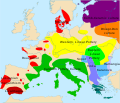The Bug–Dniester culture was an archaeological culture that developed in and around the Central Black Earth Region of Moldavia and Ukraine, around the...
4 KB (432 words) - 12:16, 2 October 2024
Dnieper–Donets culture was contemporary with the Bug–Dniester culture. It is clearly distinct from the Cucuteni–Trypillia culture. The Dnieper–Donets culture is known...
22 KB (2,306 words) - 10:02, 11 April 2024
Medieval Slavic tribes Bug-Dniester culture Carpathian Tumuli culture [1] Definition P M Barford (2001). The Early Slavs: Culture and Society in Early Medieval...
3 KB (308 words) - 03:04, 9 August 2023
Late Neolithic (section Halaf culture (6000–5000 BCE))
middle phase, the Early Linear Pottery culture intruded upon the Bug-Dniester culture and began to manufacture "musical note" or notenkopf pottery, where...
28 KB (3,068 words) - 17:51, 21 October 2024
Cucuteni–Trypillia culture can be found in the Starčevo–Körös–Criș and Vinča cultures of the 6th to 5th millennia, with additional influence from the Bug–Dniester culture...
104 KB (11,331 words) - 20:46, 29 October 2024
Transnistria (redirect from Trans-Dniester)
and occupied it. Romania controlled the entire region between Dniester and Southern Bug rivers, including the city of Odesa as local capital. The Romanian-administered...
133 KB (12,472 words) - 18:55, 30 October 2024
musical notes. The culture expanded to its maximum extent, and regional variants appeared. One variant is the late Bug-Dniester culture. Late: Stroked pottery...
76 KB (8,530 words) - 11:26, 15 October 2024
Copper Age to early Bronze Age archaeological culture of the region between the Southern Bug, Dniester, and Ural rivers (the Pontic–Caspian steppe), dating...
68 KB (7,012 words) - 14:21, 25 October 2024
formed the Criş culture (5800–5300 BCE), creating a cultural frontier at the Prut-Dniestr watershed. The adjacent Bug–Dniester culture (6300–5500 BCE)...
267 KB (29,484 words) - 03:49, 28 October 2024








